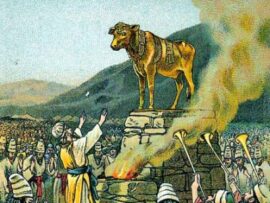If you have not heard of the “Harlem Shake,” no worries! Basically this YouTube meme has gone viral in the form of a video showing a group of individuals, all doing their own dance thing, to the song "Harlem Shake." It has surpassed 175 million views! Just to put things in perspective, 175 million people are more than twenty times the population of Israel. Alternatively, you can look at it this way: 1 in 175 million is the probability of winning the Powerball mega-lottery.
I personally have no interest in seeing this viral dance, yet its widespread popularity is intriguing. What is so amazing about this video that so many people have deemed it worthwhile to view? Washington Post columnist Debra Kaufman puts it this way: "Is it any wonder Harlem Shake videos have gone viral? It’s all in the jump cuts, which add that little jolt of magic, plus, the song’s beat is hypnotic.”
In this week's Torah portion, Ki Sisa, the Torah describes the very tragic episode of the "golden calf." The Jewish nation had just experienced arguably the most important moment in spiritual history. Every man, woman, and child had witnessed an undeniable Divine revelation at Mount Sinai. They had heard the Almighty's voice echoing forth from the mountain top with the Ten Commandments, and had been designated as the Almighty's chosen nation.
Yet, in just a short time span, they fell quickly from their lofty level, and after a confusing delay in Moshe's descent from the mountain they collectively participated in the construction of an idol in the form of a golden calf, to replace the spiritual intermediary that Moshe had been. The Torah relates how the Almighty revealed to Moshe (who had not yet descended from the mountain) the tragic scene that was playing out in the Jewish camp. He then instructed Moshe to descend to the Jewish people and take control to reverse the insanity. The Torah describes how Moshe quickly took hold of the tablets, began his descent, and was immediately met by his devoted disciple, Yehoshua (Joshua). Immediately, Moshe heard the loud noise of the idol-worship celebration. Moshe then proceeded toward the Jewish camp and was greeted with the scene of the Jewish nation dancing joyously around the golden calf. Moshe was incensed, and he threw the tablets to the ground, shattering them.
R' Yaakov Kamenetsky wonders why it took Moshe so long to smash the tablets. Wouldn't it have been more appropriate for Moshe to break the tablets immediately upon hearing that the Jewish nation had forsaken the Almighty's command and had constructed and worshipped an idol? R’ Kamenetsky explains that when Moshe first heard that the Jews had built the golden calf, he gave them the benefit of the doubt. After all, they were a nation of over three million people stranded leaderless in the desert! How would they provide food and shelter for their families? What would be their destination? Who would be their intermediary with the Almighty? He presumed that they had reluctantly formulated a plan to use the idol as a desperate attempt to feel safe. Yet, when Moshe was greeted with the scene of joyous dancing , by young and old locked arm in arm with hypnotic music, perhaps even doing their own version of the "Horeb shake," Moshe realized that they were enjoying the experience. There was no reluctance, no heavy hearts. Moshe then realized that there was no way to justify their actions, and he smashed the tablets.
At a wedding, bar mitzvah or any joyous occasion, we instinctively link arms and dance in circles around the bride or groom, the bar mitzvah boy, or even the Torah scrolls. This symbolizes the revelers’ unity in sharing the joy at the center of the festivities. It indicates our adoration and happiness as we enthusiastically encircle the "celebrities” at the center of the rejoicing, and participate in their happiness. This type of dancing demonstrates a positive form of celebration. Unfortunately, during the sin of the golden calf, the focus, the joy and the celebration all revolved around the idol. This type of dancing clearly proved to Moshe the extent of their sin. Today, there is the Harlem Shake phenomenon, where each person does his or her own thing: complete randomness, no focus, no unity, just hypnotic music and erratic body movement. I wonder where that fits into the spectrum of celebration?

